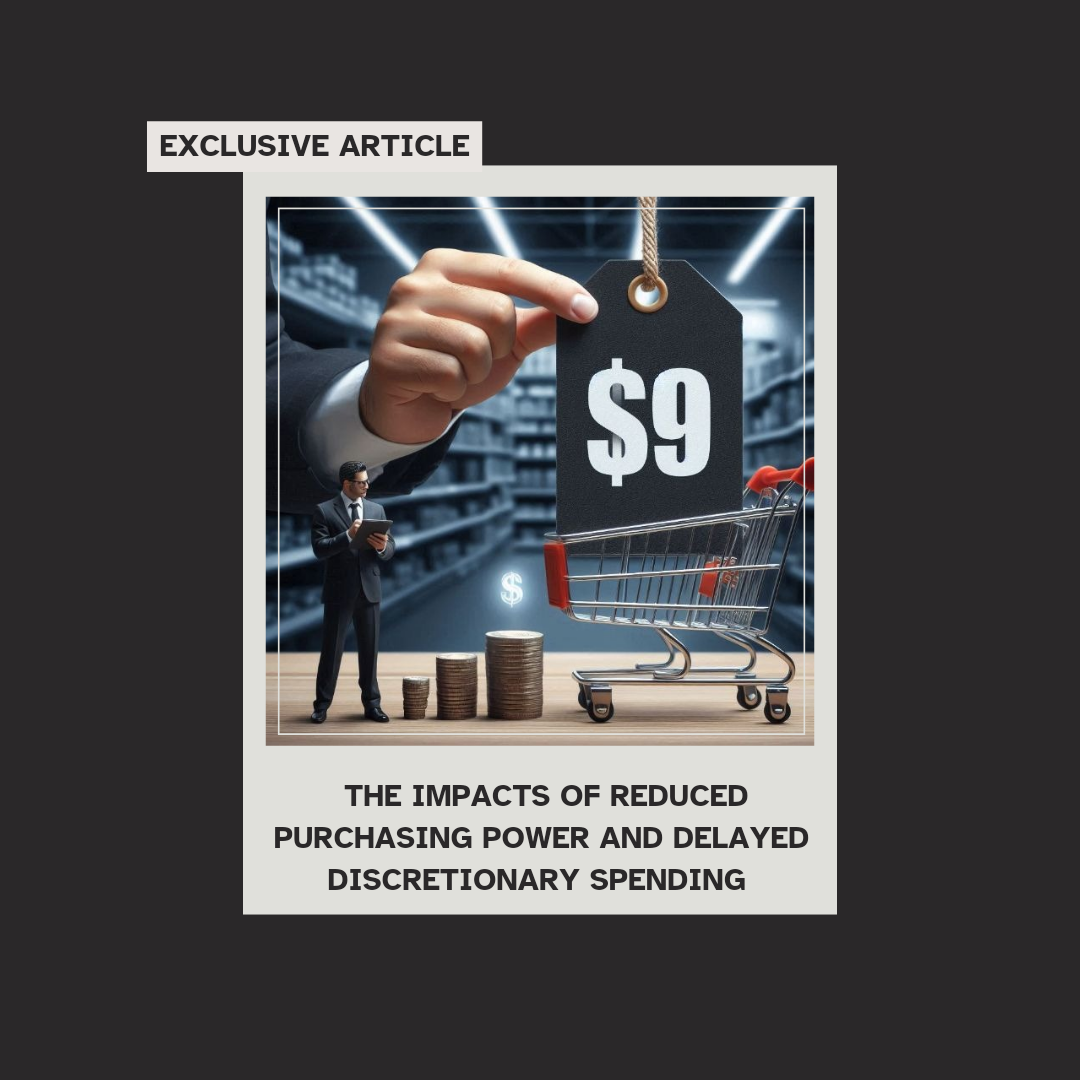Articles
Business and the Economy
EXCLUSIVE
ARTICLES
Make an impact today
Support my free content by contributing a donation.

The Impact of Sustained Economic Growth, Business Expansion, and Discretionary Marketing in an Online Enterprise
Sustained economic growth plays a pivotal role in shaping the landscape of online enterprises. When an economy is prospering, disposable income rises, leading to increased consumer spending. This shift enables online businesses to expand their operations, diversify their offerings, and invest in marketing strategies that leverage the heightened purchasing power of consumers.
In an environment characterised by sustained economic growth, businesses are often encouraged to scale their operations. This may involve expanding product lines, exploring new markets, or enhancing technological capabilities. For online enterprises, these expansions allow them to meet the growing demands of a more affluent customer base, positioning themselves as competitive players in a crowded marketplace.
Furthermore, the concept of discretionary marketing becomes increasingly significant during periods of economic prosperity. With more funds available for marketing initiatives, businesses are empowered to adopt innovative digital strategies, such as influencer collaborations, targeted social media campaigns, and advanced data analytics. This enables them to engage with consumers in a more personalised manner, enhancing brand loyalty and driving repeat sales.
However, it is crucial for businesses to approach expansion and marketing with a strategic mindset. While growth can provide opportunities, it also carries risks, including overextension and market saturation. Thus, careful analysis and planning are essential to ensure that the benefits of sustained economic growth are maximised without compromising the integrity of the online enterprise. The interplay of these factors underscores the importance of a rigorous approach to management and a keen understanding of market dynamics as businesses navigate the evolving economic landscape.
Sustained economic growth plays a pivotal role in shaping the landscape of online enterprises. When an economy is prospering, disposable income rises, leading to increased consumer spending. This shift enables online businesses to expand their operations, diversify their offerings, and invest in marketing strategies that leverage the heightened purchasing power of consumers.
In an environment characterised by sustained economic growth, businesses are often encouraged to scale their operations. This may involve expanding product lines, exploring new markets, or enhancing technological capabilities. For online enterprises, these expansions allow them to meet the growing demands of a more affluent customer base, positioning themselves as competitive players in a crowded marketplace.
Furthermore, the concept of discretionary marketing becomes increasingly significant during periods of economic prosperity. With more funds available for marketing initiatives, businesses are empowered to adopt innovative digital strategies, such as influencer collaborations, targeted social media campaigns, and advanced data analytics. This enables them to engage with consumers in a more personalised manner, enhancing brand loyalty and driving repeat sales.
However, it is crucial for businesses to approach expansion and marketing with a strategic mindset. While growth can provide opportunities, it also carries risks, including overextension and market saturation. Thus, careful analysis and planning are essential to ensure that the benefits of sustained economic growth are maximised without compromising the integrity of the online enterprise. The interplay of these factors underscores the importance of a rigorous approach to management and a keen understanding of market dynamics as businesses navigate

How To Optimize and Identify Behavioral Changes and Industrial Trends in Online Marketing
In the evolving landscape of online marketing, understanding and optimizing behavioral changes and industrial trends is critical for businesses aiming to maintain competitive advantage. A systematic approach to identifying these behavioral shifts begins with robust data analytics. Utilizing tools such as Google Analytics, social media insights, and customer feedback can provide invaluable information on user interactions and preferences.
Businesses should focus on analyzing engagement metrics, such as click-through rates and time spent on site, to detect subtle changes in consumer behavior. Segmenting audiences based on demographics, purchasing patterns, and engagement levels allows marketers to tailor their strategies accordingly.
Simultaneously, staying attuned to industry trends, such as shifts towards sustainability or increased demand for personalized marketing, is essential. Regularly reviewing market research reports and competitor analysis can help identify these trends early. Engaging in continuous learning through webinars, industry conferences, and networking with peers enables marketers to remain agile in a rapidly changing environment.
Implementing A/B testing for marketing campaigns fosters a culture of experimentation. Marketers can compare different versions of content or ads to determine which resonates better with their audience. This iterative process not only refines current strategies but also uncovers potential emerging trends dictated by consumer preferences.
Finally, leveraging customer relationship management (CRM) systems can enhance a company’s ability to predict behavioral changes through the analysis of historical data. By integrating insights gathered from various touchpoints, businesses can create a holistic view of the customer journey, enabling them to adapt and optimize their marketing efforts proactively.
In summary, the successful optimization and identification of behavioral changes and industrial trends in online marketing hinges on a combination of data analysis, industry research, audience segmentation, and a willingness to iterate and innovate based on real-time feedback and performance
In the evolving landscape of online marketing, understanding and optimizing behavioral changes and industrial trends is critical for businesses aiming to maintain competitive advantage. A systematic approach to identifying these behavioral shifts begins with robust data analytics. Utilizing tools such as Google Analytics, social media insights, and customer feedback can provide invaluable information on user interactions and preferences.
Businesses should focus on analyzing engagement metrics, such as click-through rates and time spent on site, to detect subtle changes in consumer behavior. Segmenting audiences based on demographics, purchasing patterns, and engagement levels allows marketers to tailor their strategies accordingly.
Simultaneously, staying attuned to industry trends, such as shifts towards sustainability or increased demand for personalized marketing, is essential. Regularly reviewing market research reports and competitor analysis can help identify these trends early. Engaging in continuous learning through webinars, industry conferences, and networking with peers enables marketers to remain agile in a rapidly changing environment.
Implementing A/B testing for marketing campaigns fosters a culture of experimentation. Marketers can compare different versions of content or ads to determine which resonates better with their audience. This iterative process not only refines current strategies but also uncovers potential emerging trends dictated by consumer preferences.
Finally, leveraging customer relationship management (CRM) systems can enhance a company’s ability to predict behavioural changes through the analysis of historical data. By integrating insights gathered from various touchpoints, businesses can create a holistic view of the customer journey, enabling them to adapt and optimize their marketing efforts proactively.
In summary, the successful optimization and identification of behavioral changes and industrial trends in online marketing hinges on a combination of data analysis, industry research, audience segmentation, and a willingness to iterate and innovate based on real-time feedback and performance metrics.

Income Elasticity of Demand During Economic Upturn Online
Income elasticity of demand (IED) is a crucial concept in economic analysis, particularly during periods of economic upturn. It measures the responsiveness of the quantity demanded of a good or service to a change in consumer income. When the economy is thriving, consumer incomes generally increase, impacting demand patterns across various sectors.
In an economic upturn, we can expect an increase in the demand for luxury goods and services, which often have a high positive income elasticity. As consumers feel more financially secure, they are more likely to purchase non-essential items, leading to a surge in demand for products such as high-end electronics, designer fashion, and premium dining experiences. Conversely, demand for inferior goods, which exhibit negative income elasticity, tends to decline as consumers shift their spending towards higher-quality alternatives, favouring brands that offer perceived value and prestige.
Understanding income elasticity during these times helps businesses strategise effectively. Companies can analyse their product offerings, adjust marketing strategies, and refine pricing models to better align with shifting consumer behaviours. For instance, a business observing an increase in income elastic products may consider expanding its luxury range or enhancing customer engagement through targeted promotional campaigns.
In summary, income elasticity of demand plays a significant role during economic upturns, guiding businesses in their decision-making processes and enabling them to harness growth opportunities in a fluctuating market. By closely monitoring changes in consumer income and the corresponding demand patterns, businesses can position themselves for sustained success in a thriving economy.


